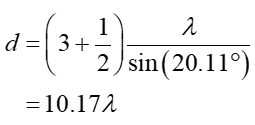
College Physics
11th Edition
ISBN: 9781305952300
Author: Raymond A. Serway, Chris Vuille
Publisher: Cengage Learning
expand_more
expand_more
format_list_bulleted
Concept explainers
Question
A student performs a double-slit interference experiment. The student records the fact that a third-order dark fringe is located at an angle of 20.11ofor a given light source. The
Expert Solution
arrow_forward
Step 1
Condition for dark fringes

arrow_forward
Step 2
Substitute for angle 20.11°

arrow_forward
Step 3
Substitute for angle 11.17°

Step by stepSolved in 5 steps with 5 images

Knowledge Booster
Learn more about
Need a deep-dive on the concept behind this application? Look no further. Learn more about this topic, physics and related others by exploring similar questions and additional content below.Similar questions
- A transmission grating has 2550 lines/cm. Consider a beam of monochromatic light normal to the surface. It is found that the angle of the first-order bright fringe is 10 degrees. What is the wavelength of the light? (in nm) OA: 681.0 OB: 796.7 OC: 932.2 OD: 1090.7 OE: 1276.1 OF: 1493.0 OG: 1746.8 OH: 2043.8arrow_forwardA student performs a double-slit interference experiment. The student records the fact that a third-order dark spot is located at an angle of 20.11 degrees for a given light source. The wavelength of light is then decreased by 40.0nm, and the student records the fact that the second-order dark spot is now located at an angle of 11.17 degrees. What is the slit separation?arrow_forwardMonochromatic red light with a wavelength of 660nm is incident on a pair of narrow slits that are separated by a distance of 4.00×10^4 *m. A viewing screen is placed a distance of 120cm behind the slits to observe the intensity pattern of the light after passing through the slits. a) Relative to the center of the pattern, where is the center of the third bright fringe?arrow_forward
- Laser light of wavelength 627.0 nm passes through a double-slit arrangement at the front of a lecture room, reflects off a mirror 29.2 m away at the back of the room, and then produces an interference pattern on a screen at the front of the room. The distance between adjacent bright fringes is 9.52 cm. What is the slit separation in meters? Number i 0.000192 Units marrow_forwardQuestion 10arrow_forwardThe figure below shows a radio wave transmitter and a receiver separated by a distance d = 50distance d = 50, 0 m, both being at a height h = 35, 0 m above the ground. The receiver canThe receiver can receive signals either directly or indirectly from reflected signals on the ground. Suppose that theground is leveled and a 180o phase shift occurs in the reflection.Determine the longest wavelengths that interferea. constructively;b. destructively.arrow_forward
- In a single-slit diffraction pattern, the central fringe is 480 times as wide as the slit. The screen is 16,000 times farther from the slit than the slit is wide. What is the ratio X/W, where is the wavelength of the light shining through the slit and W is the width of the slit? Assume that the angle that locates a dark fringe on the screen is small, so that sin is approximately equal to tan (). Number Unitsarrow_forwardA diffraction pattern forms when light passes through a single slit. The wavelength of the light is 556 nm. Determine the angle that locates the first dark fringe when the width of the slit is (a) 2.3 × 10-4 m and (b) 2.3 × 10-6 m.arrow_forwardLight is sent through a single slit of width w = 0.52 mm. On a screen, which is L = 1.9 m from the slit, the width of the central maximum is D = 5.2 mm. a) The angle of the first dark fringe theta dark. Express sin(theta dark) in terms of the wavelength of the light λ and w. sin(theta dark) = b) Express tan(theta dark) in terms of D and L. c) If D << L, how is tan(theta dark) related to sin(theta dark)? d) Express λ in terms of w, D, and L? e) Solve for the numerical value of λ, in nanometers.arrow_forward
arrow_back_ios
arrow_forward_ios
Recommended textbooks for you
 College PhysicsPhysicsISBN:9781305952300Author:Raymond A. Serway, Chris VuillePublisher:Cengage Learning
College PhysicsPhysicsISBN:9781305952300Author:Raymond A. Serway, Chris VuillePublisher:Cengage Learning University Physics (14th Edition)PhysicsISBN:9780133969290Author:Hugh D. Young, Roger A. FreedmanPublisher:PEARSON
University Physics (14th Edition)PhysicsISBN:9780133969290Author:Hugh D. Young, Roger A. FreedmanPublisher:PEARSON Introduction To Quantum MechanicsPhysicsISBN:9781107189638Author:Griffiths, David J., Schroeter, Darrell F.Publisher:Cambridge University Press
Introduction To Quantum MechanicsPhysicsISBN:9781107189638Author:Griffiths, David J., Schroeter, Darrell F.Publisher:Cambridge University Press Physics for Scientists and EngineersPhysicsISBN:9781337553278Author:Raymond A. Serway, John W. JewettPublisher:Cengage Learning
Physics for Scientists and EngineersPhysicsISBN:9781337553278Author:Raymond A. Serway, John W. JewettPublisher:Cengage Learning Lecture- Tutorials for Introductory AstronomyPhysicsISBN:9780321820464Author:Edward E. Prather, Tim P. Slater, Jeff P. Adams, Gina BrissendenPublisher:Addison-Wesley
Lecture- Tutorials for Introductory AstronomyPhysicsISBN:9780321820464Author:Edward E. Prather, Tim P. Slater, Jeff P. Adams, Gina BrissendenPublisher:Addison-Wesley College Physics: A Strategic Approach (4th Editio...PhysicsISBN:9780134609034Author:Randall D. Knight (Professor Emeritus), Brian Jones, Stuart FieldPublisher:PEARSON
College Physics: A Strategic Approach (4th Editio...PhysicsISBN:9780134609034Author:Randall D. Knight (Professor Emeritus), Brian Jones, Stuart FieldPublisher:PEARSON

College Physics
Physics
ISBN:9781305952300
Author:Raymond A. Serway, Chris Vuille
Publisher:Cengage Learning

University Physics (14th Edition)
Physics
ISBN:9780133969290
Author:Hugh D. Young, Roger A. Freedman
Publisher:PEARSON

Introduction To Quantum Mechanics
Physics
ISBN:9781107189638
Author:Griffiths, David J., Schroeter, Darrell F.
Publisher:Cambridge University Press

Physics for Scientists and Engineers
Physics
ISBN:9781337553278
Author:Raymond A. Serway, John W. Jewett
Publisher:Cengage Learning

Lecture- Tutorials for Introductory Astronomy
Physics
ISBN:9780321820464
Author:Edward E. Prather, Tim P. Slater, Jeff P. Adams, Gina Brissenden
Publisher:Addison-Wesley

College Physics: A Strategic Approach (4th Editio...
Physics
ISBN:9780134609034
Author:Randall D. Knight (Professor Emeritus), Brian Jones, Stuart Field
Publisher:PEARSON